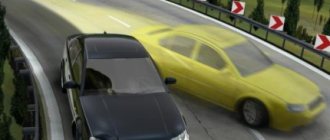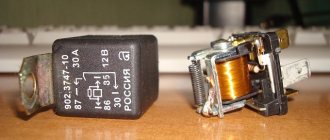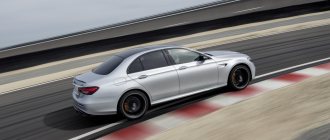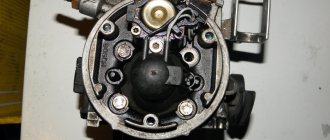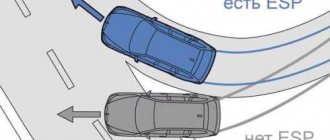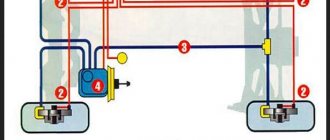The equipment of a modern car makes the driving process simple. At the same time, one cannot say that this is too easy. It is necessary to take into account many nuances in order not to end up on the sidelines not only of the road, but also of life. Road curves, weather conditions, driving experience and much more are important. The car can behave unpredictably on the road. Loss of control can cause an accident. How to prevent such developments?
This can be done using ESP. This abbreviation hides a system that provides directional stability. From the perspective of the English language it stands for: Electronic Stability Program.
What is ESP
It refers to a security system that uses a computer to control the car in unusual situations. If the car loses stability on the road, that is, it begins to follow a dangerous trajectory, then its position is forcibly leveled.
ESP is not a uniform designation for dynamic stabilization systems. This is a popular brand and nothing more. Therefore, we will consider it specifically. Although other similar systems have their own popularity, for example, ESC and DSC.
Why do you need an electronic car stabilization system?
One of these programs, together with sensors, microcomputers and actuators, is called the Electronic Stability Program (ESP), which means a system for controlling the stability of the car when the wheels lose traction or are on the verge of such loss.
This is important: Which is better all-wheel drive, front or rear?
It is not necessary to use exactly this term; different car companies may use other designations, including in other languages.
ESP is designed to provide directional stabilization of the car, that is, the ability to move predictably for the driver and not lose control, as much as possible.
Naturally, when the clutch is completely lost and no action can help, not only the driver, but also all his automatic assistants will turn into a passenger, a miracle will not happen.
But if it is still possible to return the car to the trajectory and calm its vibrations, but the driver, for various reasons, cannot cope with this, then the electronics will definitely help.
To a certain extent, ESP can be compared to an ideal person, with instant reactions and the best skills, and also has controls that the driver does not have at all.
Story
The first patent for a system of this type was issued in 1959. The development was called “Control Device”. It was initiated by the Daimler-Benz concern. The result was mediocre. The concern's engineers were unable to offer a product that could become a real driver's assistant.
Everything changed after many years. In 1994, premium Mercedes were equipped with a full-fledged security system. Somewhat later, exchange rate stabilization became available on production vehicles from Mercedes-Benz.
Statistics on the use of ESP on cars
When all modern motorists already know what ESP is, whether it is worth taking a package with this function and overpaying for the car upon purchase, the time has come to talk about the real benefits of this system. The main task of any active or passive vehicle safety function is to prevent possible accidents, which often occur when control control is lost.
This is precisely the task that the creators of the ESP system for cars set for their developments. Using incredibly sensitive sensors, the module reacts within 20 milliseconds and activates all the necessary devices to prevent skidding. This is confirmed by many statistics:
- the number of accidents in winter on cars with ESP has almost halved;
- insurance companies in the USA and Europe have begun the practice of reducing the cost of insurance for cars with such a system;
- Manufacturers are investing more and more money into improving this function;
- Not so long ago, the ESP system successfully migrated to sports cars, although its features contradict sports.
Of course, the most visible benefits from using this technology will be received by novice drivers who do not yet have enough experience and practice to overcome difficult road situations. Previously, the ABS function was considered the exclusive prerogative of novice drivers, but today in some countries the sale of new cars is prohibited without the use of this braking assistant.
Device
By itself, ESP is not capable of performing the tasks assigned to it. Electronic sensors are required to help. A special unit processes the signals coming from them. The electronics promptly inform the system about the vehicle’s inappropriate behavior, which makes it possible to regain control of the vehicle.
The list of constituent elements is formed by:
- the main unit, designed to process signals from sensors and control specific devices;
- sensors that record how fast each wheel rotates;
- sensors that measure the speed and axial deviation of the vehicle. Sensors of this type are located inside one housing;
- a controller capable of determining how the steering wheel changes its angle of rotation;
- hydraulic unit that initiates braking forces.
Assistants also include the following systems:
- ABS – eliminates the possibility of wheel locking during braking;
- EBD – force distribution when controlling brake discs;
- ASR – control of how much the wheels slip, followed by redistribution of torque. Slipping is eliminated;
- EDS is an addition to ASR. Blocking of the differential mechanism.
Malfunctions
Since ESP is based on all the main components of the anti-lock braking system, its malfunctions are also related to them. Violations in the operation of the program itself are unlikely.
- Most often, wheel rotation sensors and their wiring fail, since they work in the most difficult conditions.
- Problems may be related to the hydraulic unit, its pump and valves. Especially if you neglect the scheduled brake fluid replacement.
- All other sensors fail no more often than any other electronics; natural aging of components, moisture and corrosion can be the reasons. As always, pay special attention to the wiring.
In the event of a failure, the self-diagnosis system will illuminate the corresponding lamp on the instrument panel. Driving without ESP is very undesirable, the behavior of the car will become unusual, and with the most powerful engines the driver may simply not be able to control it.
How it works
Exchange rate stabilization via ESP is not possible without ABS. The anti-lock braking system is an important point in adjusting the behavior of the car. The stabilization process is also ensured through the functionality of the traction control system and a unit capable of changing the engine operating mode.
ESP determines the development of skidding using several parameters. For example, at a small angle of rotation of the wheels, an excess of lateral acceleration and a significant change in the angle of rotation of the vehicle may be recorded. This goes beyond “driving properly,” so the system comes into play.
In practice, specific wheels slow down or the braking force weakens. The hydraulic modulator changes the state of the brake system in terms of its pressure. The operation of the power unit is being adjusted. The controller unit reduces the fuel supply, which reduces the torque transmitted to the wheels. As a result, the car is given its previous trajectory.
The structure has a main block that receives and processes information coming from sensors. This information means several points: at what speed the wheels rotate, in what position the steering wheel is and how much pressure in the brake system corresponds to the norm. Based on such data, ESP decides how to act. In this case, the most important signals are from two sensors that read lateral acceleration and angular velocity.
Let's look at an example of a simplified diagram of how exchange rate stabilization occurs.
Skid
The block controller receives data:
- the rear axle begins to shift in the direction it is skidding;
- the sliding speed is outside the permissible limits.
If you are an experienced driver, then step on the gas and try to get out of the skid. The key word here is “experienced,” but the majority of people driving are those who have not been in similar situations. They may get confused. Inattention is also something to consider. This is where the need for ESP comes into play.
The system returns the car to its previous course by braking the front wheel from the outside.
Demolition
Sensors signal unusual behavior of the vehicle:
- the displacement of the front axle is recorded in a direction such as the outer side of the turn;
- The yaw rate is determined to be low.
The system stabilizes the car, which is achieved by braking the rear wheel from the inside.
Advantages and disadvantages
All the advantages of the system are clear from the description of its actions in critical situations. She will save the car when nothing else can help it.
Moreover, when driving fast, sometimes inexperienced drivers in independent tests were ahead of motorsports drivers who did not have such a system. You shouldn't hope for it, but ESP multiplies the driver's abilities, unless of course they are zero.
But unpleasant situations also happen.
- In the most severe cases, ESP is ineffective, the wheels no longer have grip on the road, and it is not trained in non-standard techniques of an experienced driver.
- Engine traction control algorithms are still poorly developed, especially adding it to front-wheel drive and all-wheel drive vehicles. Although for those same motorsports athletes these are the basics, without which they have nothing to do on the road. But such techniques are difficult to automate.
- Sometimes the system misunderstands the chaotic rotation of the steering wheel by an inexperienced driver. According to the logic of security inherent in it, to put it simply, it must obey a person whose abilities are unknown to it. Therefore, ESP does not yet have the right to act radically by removing him from control.
To combat shortcomings, there is one remedy - the ESP disable button, available on many cars. It should be used only when the consequences are precisely known.
Although the system does not completely turn off in this case, the threshold for its intervention is simply significantly reduced.
Conclusion
Some car enthusiasts believe that ESP is an obstacle to normal driving and the impossibility of getting out of critical situations. The last statement is true, but partly. The percentage of inappropriate ESP behavior is negligible.
The system that provides directional stability is effective. It does not allow drivers to behave too freely on the road. Driving attempts that go beyond what is permitted are stopped. The loss of power on slippery surfaces in off-road conditions is covered by electronic imitation of blocking, which helps to overcome obstacles when diagonal hanging occurs.
1-UBK-20781
Redundant system architecture
The car will soon become much safer; like modern aircraft, it will have various systems that duplicate each other. This is, first of all, necessary to ensure that a sudden failure of one of the systems does not lead to an accident.
Bosch specialists have already developed backup brake system technology. The electromechanical brake booster iBooster and ESP (electronic stability control) allow you to stop the car independently of each other.
Highly accurate map data
Now the positioning accuracy of modern navigation systems is within one meter. For a safe autopilot, the accuracy must be increased at least ten times. In addition, maps should be updated more often. Our habit of installing new signs while the road is being repaired, and then forgetting to remove them, can drive the car’s cybernetic brain crazy. For example, when the video camera detects a “brick” and the navigation determines the road as one-way. Where should we go then? After all, the ban on violating traffic rules will be the main one for artificial intelligence.
We have listed only three problems, while there are dozens of them on the way to creating an autopilot! And yet there is hope that in ten years we will be able to go to the dacha early in the morning in a “smart” car, and on the way sleep peacefully in the driver’s seat.
ESP system: where are we heading?
What is EPC in a car?
Not all car owners can answer this question. This confirms that they are not even aware of its features. The presence of an EPC system in a car provides the following advantages:
- you can save fuel. A car equipped with this system has average fuel consumption;
- makes it possible to configure and adjust the system yourself. The driver can independently increase or decrease the sensitivity of the sensors;
- Due to its compactness, it can be used in various modifications of cars. Domestic manufacturers are in no particular hurry to implement EPC, which cannot be said about European concerns.
Operating principle
The main task of the ESP electronic stabilization system is to align the vehicle in the direction of the front wheels. A car equipped with ESP contains:
Sensors that determine its position in space;
Wheel rotation sensors;
Sensor that determines the steering angle;
Pump that controls the brake lines of the wheels;
ECU – electronic control unit. It polls each of the wheel sensors at an astonishing rate of up to 30 times per second. The ECU also accesses the steering and axle rotation sensors - Yaw Sensor.
The ECU processes data from all control sensors. If they do not converge, ESP forcibly takes control of the fuel supply and braking system, aligning the car in the direction of the front wheels. The important thing is that electronics are not that smart
to know where the safe part of the road is next, so you have to steer the wheels yourself, thereby helping the ESP do the rest of the work.
At first glance, it may seem that experienced drivers have no need to use the help of this system, because in an emergency they can rely on their skills, confidence and experience. But this is a big misconception! In an emergency, ESP correctly regulates the fuel supply and selects exactly the right wheels
to brake, which are needed to stabilize the car.
If the situation arises that the front wheels are being demolished because the entrance to the turn has determined that the car is oversteerable, the ESP system applies the rear brakes by braking the wheel that lies on the inner radius of the turn. This action will straighten the “front” of the car, which goes into the demolition.
The opposite case may also occur when the car is poorly controlled and there is a slip in a turn with the rear of the car skidding. In this situation, the ESP system engages the front brakes, braking the wheel on the outer turning radius.
Some drivers believe that ESP interferes with driving. We want to refute this and prove that this is 100% wrong. Firstly, in any case, a person, with all his controlled physical capabilities (now we are talking about ordinary people without any phenomenal abilities: radiation, a radioactive spider bite, etc.) cannot act the way ESP electronics do. Secondly, a basic test of one’s strength on an ice training ground
You will immediately be dissuaded of the opposite.
At high speeds, cars equipped with ESP have a much greater chance of not flying off the road than those without it. Thirdly, people who believe that the stabilization system is unnecessary in a car are simply trampling on elementary physical laws, not knowing the principle of operation of ESP. It’s just enough to understand the main principle of ESP in order to change your opinion to the opposite in practice.
The developers claim that situations on the road cannot arise where ESP can cause harm, only hopeless ones can happen.
Where to start repairs?
You can call each sensor, check the ABS system, voltage, position of the steering wheel, and other units yourself, but it is labor-intensive. It’s easier to take the car to a diagnostic center, where auto mechanics will connect a scanner and count errors indicating the malfunction: sensor, wiring, unit.
Things are more complicated if the breakdown is of a “floating” nature. In such cases, as a rule, the light comes on while driving, and goes out the next time the engine is started. In this case, you can attach the scanner and drive with it to fix the fault. There are also a number of indirect signs that will help identify the problem.
Indirect signs of the cause of the breakdown
- incorrect operation of the rear brake lights at the same time as the EPS sign is on indicates that it is necessary to check the brake pedal sensor,
- If there is a voltage drop, you need to check the fuse,
- if any repair work was carried out before the light began to light up, then examine the sensors and wires at the place of repair work.
If there are no such clues, then the problem can only be identified using a scanner.
You can drive for a long time with a faulty stabilization system, but the safety of the car's passengers is at risk, and the cost of the issue may be scanty.
What is EPC system in car
A modern car is “stuffed” with electronics.
The undeniable advantage of this is the ease of self-diagnosis, because the car can inform the driver about most faults immediately at the moment they appear. It is clear that an excess of informers does not make the life of a motorist any easier, because several light bulbs that light up at the same time can unsettle him. One of the most confusing instruments is the EPC. Questions are often asked about EPC: what is it in a car, why is this indicator needed and is it possible to do without it. Unfortunately, or fortunately, not all automakers supply their cars with it. VAG and Mercedes cars . From the moment they began to be equipped with electronic throttle valves, the concept of Electronic Power Control . This is an electronic control of engine power, which, in combination with other systems, helps optimize engine performance. If you don’t yet know what it is about Audi EPC, now is the right time to get to know it.
